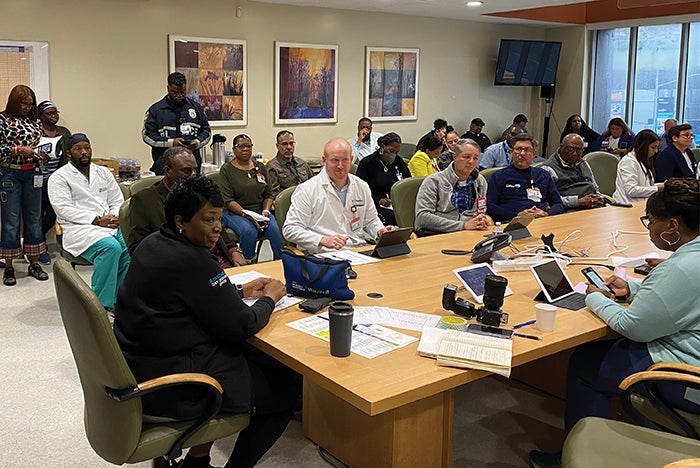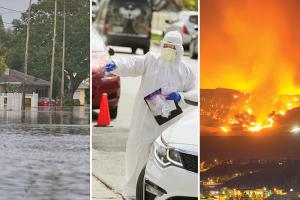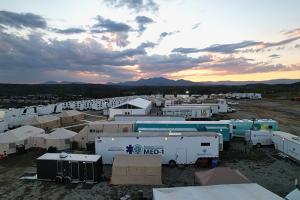Extreme weather events cause more waves of patient evacuations

Woodhull’s Hospital Incident Command System works with both internal and external stakeholders during emergency events.
Image courtesy of NYC Health + Hospitals/Woodhull
Although it is a rare occurrence among health care facilities, there is little room for error when it comes to patient evacuations. However, if the complex and multidisciplinary coordination that is required for a successful patient evacuation is anything less than tight, it unfortunately tends to leave lots of room for error. The need for high-level communication is not the only challenge hospitals face when it comes to establishing a synchronized process for patient evacuations that “do no harm.”
Patient evacuations can be triggered by an array of events, requiring health care organizations to devise a single or several well-formed plans able to absorb some degree of flexibility. An evacuation can be spurred by a human-made threat, infrastructure failure or — a more frequently occurring cause — adverse weather. Treating patients of varying levels of acuity and ability also increases the challenge of safely evacuating patients. For instance, a premature infant relying on IV treatment demands different evacuation care than an adult patient who is on the tail end of a successful surgery recovery.
Leah Hummel, AIA, CHFM, CHC, senior associate director, regulatory affairs, at the American Society for Health Care Engineering (ASHE), says that although patient evacuations should be a last resort, the events leading to one are often unavoidable and sometimes unforeseen, but that doesn’t mean they can’t be extensively planned for.
“The hardest part of planning for an evacuation is the unknown,” Hummel says. “Depending on the event that causes it, there could be an added layer of complexity or roadblocks thrown in front of a hospital’s path. The best thing to do is to come up with your best laid plan, do your best to stick to it and be willing to be flexible.”
Putting plans into action
HCA Healthcare Inc., one of the largest health care providers in the U.S., is well-versed in emergency planning. With 180 hospitals and approximately 2,300 ambulatory care sites spread throughout the country, HCA pays close attention to areas in Florida, Texas, Louisiana, South Carolina and Georgia during hurricane season.
HCA’s Enterprise Emergency Operations Center (EEOC) creates and distributes key resources to its facilities, including a hurricane playbook, to help susceptible facilities maintain continuity of care and work to avoid evacuation during the Atlantic hurricane season, which runs from June to November. However, when an evacuation is needed, the health system pulls on several tools and resources to streamline the process.
Hurricane Idalia, which hit Florida in August 2023, prompted the evacuation of three of the organization’s hospitals. Patients at HCA Florida Trinity West Hospital in New Port Richey and HCA Florida West Tampa Hospital were transferred to other HCA facilities via ambulances. HCA Florida Pasadena Hospital in St. Petersburg ferried patients from the peninsula to other facilities, marking the second consecutive year the hospital had to close temporarily due to a major storm.
In all three instances, HCA drew from its more than 50 years of experience in hurricane planning, as well as specially created tools to manage each one successfully.
The health system’s EEOC uses triage data available through an algorithm called evacuNATE to improve transfer center protocols and help reduce hospital evacuation time. EvacuNATE keeps track of where patients currently are, their care needs and where alternative care is available, which helps simplify the transfer process and streamline communication between HCA care teams. In 2022, the EEOC coordinated with its strategic air transport partner to establish an internal neonatal intensive care unit incident support team (NICU IST). If a NICU evacuation is required, this team comprised of highly specialized HCA Healthcare nurses and respiratory therapists from across the country deploy to help transfer NICU babies.
“We owe it to our patients to be able to care for them when it is needed most,” says Sam Hazen, CEO, HCA Healthcare. “Our preparedness efforts are a prime example of how we’re showing up for our patients, colleagues and communities.”
As climate change increases, Hummel says facilities will have to stay prepared for emergencies such as these.
“Anecdotally, we hear of these types of weather-related events happening with more frequency and intensity,” she says. “It’s becoming more and more important that hospitals do this emergency planning and prepare for whatever can happen.”
Even areas that in decades past were spared from the extreme rainfalls experienced in southeastern states are factoring flooding into their emergency operations planning to a greater degree.
Prepared for the unexpected
The NYC Health + Hospitals/Woodhull in Brooklyn, N.Y., was impacted by heavy rains in the fall of 2023 that required the transfer of 116 patients. Lisa Scott-McKenzie, DHA, CEM, FABC, FACHE, chief operating officer, says flooding inundated New York City’s aging infrastructure, causing water intrusion at the 364-bed hospital.
The flooding also led to the city’s local electrical grid catching fire in various places. Woodhull’s emergency generators kicked on to take on the electrical demand, but the hospital’s leadership was informed by its utility provider that repairs to the local city grid could not proceed while the hospital was powered.
“We were forced to make the difficult decision to leave our facility for the first time in our history,” Scott-McKenzie says. “Fortunately, Woodhull performs several emergency management exercises per year that make good use of both drills and actual events to maintain a high level of readiness. This was especially helpful to us as our teams were well accustomed to working together and with community partners.”
NYC Health + Hospital’s Hospital Incident Command System (HICS) activated early to track the incident and gain situational awareness in order to make decisions and act quickly. The HICS coordinates with senior executive leadership teams and emergency management, operations, clinical, and ancillary service leads systemwide. It also collaborates with citywide first responders, including New York City’s emergency management, fire, emergency medical services and police departments, to assess capabilities at a given location and help determine the safest options for patients.
“Collaboration with key partners and stakeholders [and] communication with staff, patient families and the media, as well as city and state leaders, in a transparent manner is key to the successful management of any emergency preparedness event in New York City,” Scott-McKenzie says. “It is wise to pre-plan the types of systems that will be used and to pre-stage and test these systems periodically. Pre-testing also allows for communication drills of staff contact lists to ensure adequate staffing levels may be available throughout the event as well as during the recovery phase.”
Mitigating facility hazards
Although it’s impossible to predict all the emergencies that will happen each year, Hummel says health care organizations certified by the Centers for Medicare & Medicaid Services are required to update their emergency plans every two years and take an all-hazards approach when doing so. The first step in doing that is to conduct a hazard vulnerability analysis (HVA).
“The emergency management team needs to look at all the different hazards that their facilities are subject to, such as flooding, wildfires, etc.,” Hummel says. “Once the organization has made the list, they need to look at the likelihood of each one of those events occurring and then take into effect the impact each event would have on the organization if it does occur.”
Specifying impact provides a critical distinction to aid in planning, Hummel explains.
“I like to give this example: North Dakota has lots of blizzards, and so the likelihood of one happening is really high, but the impact is relatively low because the infrastructure is built for it,” she says. “But if you take that same blizzard and put it in Texas where that doesn’t happen very often, although your likelihood is way down, the impact to the organization is much higher because it may not have the equipment to handle that.”
ASHE offers a complimentary resource called the Hazard Vulnerability Assessment Tool to assist multidisciplinary teams in assessing and prioritizing potential risks and mitigation strategies. It can be downloaded at ashe.org/hva.
Conducting an HVA can also awaken teams to blind spots in their facility design and infrastructure that can help deter patient transfers. With scientists predicting a continued trend of more frequent and severe weather-related natural disasters, ongoing infrastructure assessment is vital.
After the evacuation of Woodhull Hospital, New York City Mayor Eric Adams pointed out that the need for electrical repairs to the local grid that triggered the hospital evacuation speaks to a greater issue.
“It’s more important than ever that we get the federal resources we need to continue to build new infrastructure that can handle these threats,” he says.
For their parts, organizations such as HCA Healthcare and Woodhull Hospital say they are just as diligent in investing in their infrastructure as they are in planning for patient evacuations.
Scott-McKenzie says a “significant portion” of Woodhull’s funding goes toward infrastructure upgrades, such as boilers, fire alarm systems, electrical systems, roofing, facades and ramps.
“We must begin to expect these types of occurrences throughout the city as we continue to experience more severe weather,” she says. “Capital budget planning must include funding to build resiliency into our safety-net facilities. Appropriate planning now may allow us to avoid incidents like this in the future.”
At HCA Healthcare, the EEOC redirects the supply chain to funnel medical supplies, equipment and care teams to impacted areas during a natural disaster. It also pre-positions resources such as temporary generators, bulk water and fuel supply. During the 2023 hurricane season, HCA stationed trailers equipped with 3,000 flood control barriers and other storm readiness equipment in its Gulf Coast and West Florida regions.
“Our job is to ensure the infrastructure is in place — the supplies, equipment, buildings and everything it takes to deliver care — and that our colleagues and patients are taken care of,” says Michael Wargo, R.N., BSN, MBA, PHRN, CMTE, vice president of HCA Healthcare’s enterprise emergency operations and medical transport. “We are proud of our response to previous major incidents and strive to make our procedures even more seamless so that continuity of care remains uncompromised.”
ASHE offers a resource called the Hazard Vulnerability Assessment Tool to assist teams in assessing and prioritizing risks and mitigation strategies.




